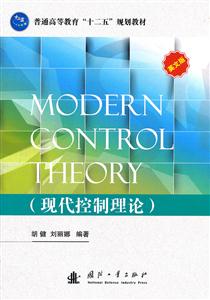Chapterl State Space Description 1.1 Definition of State Space 1.1.1 Exmple 1.1.3 State Space Description 1.1.4 Tra�fer Function Matrix 1.2 Obtaining State Space Description from I/O Description 1.2.1 Obtaining State Space Description from Differential Equation 1.2.2 Obtaining State Space Description from Tra�fer Function 1.2.3 Obtaining State Space Description from Block Diagram 1.3 Obtaining Tra�fer Function Matrix from'State Space Description 1.4 Description of Composite Systems 1.4.1 Basic Connection of Composite Systems 1.4.2 Description of the Series Composite Systems l.4.3 Description of the Parallel Composite Systems 1.4.4 Description of the Feedback Composite Systems 1.5.1 Eigenvalue and Eigenvector 1.5.2 State Tra�formation 1.5.3 Invariance Properties of the Stare Tra�formation 1.5.4 Obtaining the Diagonal Canonical Formby State Tra�formation 1.5.5 Obtaining the Jordan Canonical Form by State Tta�formation ProblemsChapter2 Time Respo�e of the LTI System 2.1 Time Respo�e of the LTI Homogeneous System 2.2 State Tra�ition Matrix 2.2.2 Properties oi the State Tra�ition Matrix 2.3 Calculation of the Matrix Exponential Function 2.3.1 Direct Method 2.3.2 Laplace Tra�form Method 2.3.3 SimdariTy Tra�foRation Method 2.3.4 Cayley Hamihon Theorem Method 2.4 Time Respo�e of the LTI SystemChapter3 Stability of the control System 3.1 The Basics of Stability Theory in Mathematics 3.2 Lyapunov Stability 3.2.1 Equilibrium Point 3.2.2 Cocepts of Lyapunov Stability 3.3 Lyapunov Stability Theory 3.3.1 Fyapunov Fi�t Method 3.4 Application of Lyapunov 2 Method to the LTI System 3.5 Co�truction of Lyapunov Function to the Nonlinear System Chapter4 Controllability and Observability 4.1 Controllability of The LTI System 4.1.1 Cntrollability 4.1.2 Criteria of ControlIabillty 4.2 Observability of The LTI System 4.2.1 Observahility 4.2.2 Criteria of ()bservability 4.3 Duality 4.4 Obtaining the Controllable and Observable Canonical Form by State Tra�formation 4.4.1 Obtaining the Controllable Canonical Form by State Trahsformation 4.4.2 Obtaining the Obserable Canonical Form by State Trarlsformation 4.5 CanonicaI Decomposition of-the LTI System 4.5.1 Controllable Canonical Decomposition 4.5.2 Observable Canonicl,Decompqsition 4.5.3 Canonical Decomposition 4.6 MinimaI Realization of the LTl System 4.6.1 Realization Problem 4.6.2 Realization of SISO System 4.6.3 Realization.of MIMO System 4.6.4 Minimal Realization Problems Chapter5 Synthesis of the LTI System 5.1 State Feedback ControI of the.LTI System 5.1.1 State Feedback 5.1.2 Controllability and Observability of the Closed-Loop System 5.1.3 Poles Placement by State Feedback Control 5.1.4 Zeros of the Closed—Loop Systemr 5.2 Design of the State Observer 5.2.1 Full—Order State Observer: 5.2.2 Design of the Full-Qrder State Observer 5.3 Feedback System with the State ObserverProblemsChapter6 Discrete Time Control System 6.1 State Space Description of Discrete Time System 6.1.1 State Space Description of.Discrete Time System 6.1.2 Obtaining State Space Description from Difference Equation orImpulse Tra�fer Function 6.1.3 Obtaining Impulse Tra�fer Function Matrix from StateSpace Description 6.2 State Equation Solution.of Discrete Time LTI System 6.2.1 Iterative Method 6.2.2 Tra�form Methodi 6.2.3 Calculation of the State Tra�ition Matrix 6.3 Data.Sampled Control System 6.3.1 Realization Method 6.3.2 Three Basic Assumptio� 6.3.3 Diseretization from the State Solution of Continuous Time Systern 6.3.4 Approximate Discretization 6.4 Discrete Time System Stability Analysis and Criteria 6.4.1 Lyapunov Stability of Discrete Time System 6.4.2 Lyapunov Stability Theorem of Discrete Time System 6.4.3 Stability Criteria of Discrete Time LTI System 6.5 Controllability and Observability of Discrete Time LTI System 6.5.1 Controllability 6.5.2 Observability 6.5.3 Condition of Remaining Controllability and Observability by Sampling 6.6 Control Synthesis of Discrete Time LTI System. 6.6.1 Design of Poles Placement 6.6.2 State ObserverProblemsIndexReferences

















